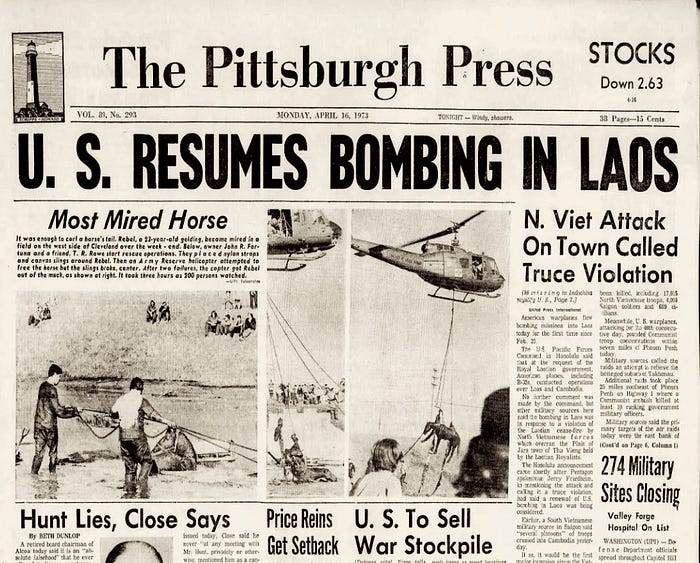Final Edition
After 58 years, the era of the newspaper ends at our house.

First published in my Substack newsletter, Unsorted but Significant, November 2023.
YESTERDAY MORNING, I padded out to the edge of our driveway in suburban Pittsburgh on a crisp, sunny fall Sunday to retrieve a thin blue plastic bag and scurry back inside in my socks. In doing so, I ended an era that I believe helped steer my life.
Inside the bag was, well, another blue plastic bag. Inside that, folded and rolled per usual, sat the Sunday, Nov. 19, 2023, edition of The New York Times.
For 58 years, until this morning, a newspaper made its way to our doorstep — often daily, for a brief period twice a day and, of late, once a week. But it came.
Our first color TV was set up in the late 1960s, around the time I was born, around the time Dan Rather was roughed up while reporting live from the Democratic National Convention in Chicago, and still the newspaper arrived on our doorstep.
My father set up his Apple IIc and 300-baud modem in his study in 1984, and still the newspaper arrived on our doorstep.
The inaugural iPhone was tucked into my left hip pocket the summer I moved back into this house in 2007 with my own young family, and still the newspaper arrived on our doorstep each day, a paper digest of an increasingly complex world.
And then there was this morning. The news of the day was streaked with tears, as news often is: “Smoldering Gaza Becomes A Graveyard for Children.” “Thousands Are Killed in Bombardment.” “Jan. 6 Defendant Pleads Case to the Son Who Turned Him In.”
We will see those stories elsewhere now. Our budget can no longer justify the cost of four Sunday papers containing articles that we already enthusiastically subscribe to online.
So that doorstep-arriving, physical representation of the news — the solid, inky item that launched a thousand scissored-and-mailed clippings from my mother across the years and, I think, was instrumental in making me into a journalist — has arrived for the final time.

MY LATE PARENTS WERE, like so many in the 20th century, a committed newspaper-reading family from a long line of committed newspaper-reading American families going back to the mid-1800s.
They came of age with great Midwestern papers like the Cleveland Plain Dealer, The Cincinnati Post and the Detroit Free Press. And they didn’t just look at the paper; they devoured it, from the most cataclysmic front-page news (that, my older sister reports, sometimes made my mother cry as she read) to the sports section to the recipes, all the way back to the “Jumble” and long-gone comic strips like “Dondi” and “Crock.” They read it together at the kitchen table, together in the living room, alone in their respective studies. They wrung it dry, then sat and talked about the news once they were done, often holding up a page to prove a point much like we do today with a freshly Googled iPhone.

I was always included in the discussions about what was in the paper; I learned early on that being conversant about what was going on — sometimes from KDKA-AM radio but mostly from the newspaper — was one of my key entry points into substantial conversations about the world that they, like so many, struggled to understand.
When they moved to Pennsylvania from Michigan in 1965 and built the house where we now live, they “took” — for some reason the verb was always “took” — The Pittsburgh Press, then the area’s afternoon paper. That was the newspaper on which I cut my reading teeth, at the kitchen table every night after school and before dinner across the 1970s and early 1980s. During baseball season, I favored the sports section; when we spent a year in China in 1979–80, it was the Press’ coverage of the Pirates that I missed the most.
Now and then, when one of the neighborhood paper boys (sadly, in my area they were always boys) was on vacation, I’d sub for them and deliver the Press across our suburban neighborhood. I’d like to tell you that I walked the route, or biked it uphill both ways in the snow; the truth is, my father drove me around in his 1975 Ford Pinto and stopped at each house, where I’d bolt from the car and leave the paper on the doorstep, then bolt back. More than a decade later, my first journalism dream was realized when I had a byline in the Press while in college; Pittsburgh Press bylines were in bolder type than other, more anemic bylines, which was an added bonus.

The Press died in 1992, the casualty of a strike. A decade earlier, my parents had shifted to the morning Pittsburgh Post-Gazette, meaning that the family conversations about the world were happening not at dinnertime but over breakfast before school, which made me even more insufferable in my history and civics classes.
They also started getting The New York Times when it became available in Pittsburgh for home delivery. And that subscription — curtailed to a weekly Sunday edition shortly after we moved in and they and their Post-Gazette subscription decamped to an independent living facility — was where our newspaper delivery status stood for 15 years, until yesterday morning.

IT IS LONG PAST CLICHÉ these days, in a decidedly “OK, boomer” kind of way (though with a birth year of 1968 I am not quite a boomer), to lament the demise of print.
News moves around in atomized ways now and has for more than a decade, across social media and through unremitting push alerts on phones. Articles (though we tend to call them “pieces” these days) increasingly stalk the world as lone wolves wandering the digital wilderness; either that or they travel in packs, bound to each other by hyperlinks. Curation is the prevailing mantra; “front-page news” is well on its way to becoming a quaint idiom, taking its place alongside “hanging up” the phone and “rolling down” the car window.
Yet as a reader — even putting my decades working in journalism to the side — something about me still adores the newspaper in all its physicality, even now.
My wife still tackles the Times crossword puzzles vigilantly (if out of order), armed with a clipboard full of them harvested from the back pages of 15 years of New York Times Magazines that I struggled for years to keep up with but failed. Same with the Book Reviews, which have shaped my reading world since I was in college. A couple days ago, after 15 years of accumulation and trying to keep up, I finally got through the final ones that we’d put aside. The piles — in the living room, in the dining room, in the family room, at times nearing hoarder proportions — are gone.
Now, no more will be coming in.
Part of me shudders at what my mother would say. “You CANceled your subSCRIPtion?” Yet upon further reflection, I think she might have understood. Yes, she was still faithfully reading the physical Post-Gazette at her apartment in assisted living mere days before she died, but she also entered the world of online news (reluctantly, at first) with a laptop computer in 1998 and ingested just as much news from there as she did from the newspaper.
Yet the question persists: Why did a sheaf of paper that landed on our driveway in a plastic bag once a week feel, in some ways, like a more robust connection to the outside world than a 24-hour cable network or the entire universe of news at my fingertips on an iPad?
Honestly, I don’t know. Perhaps it is one more way in which the solid is becoming the theoretical. And perhaps solid still means something in the era after analog’s twilight, even if we don’t have the vocabulary quite yet to articulate exactly what.
Whatever the case, I’m going to read — very closely — that final edition of the Sunday Times that our house contains. Then, after that, I suppose I’ll wash my hands — of any errant ink, and of one small, tangible sliver of the past.

Further reading by Ted Anthony:
©2023, Ted Anthony. All rights reserved.
